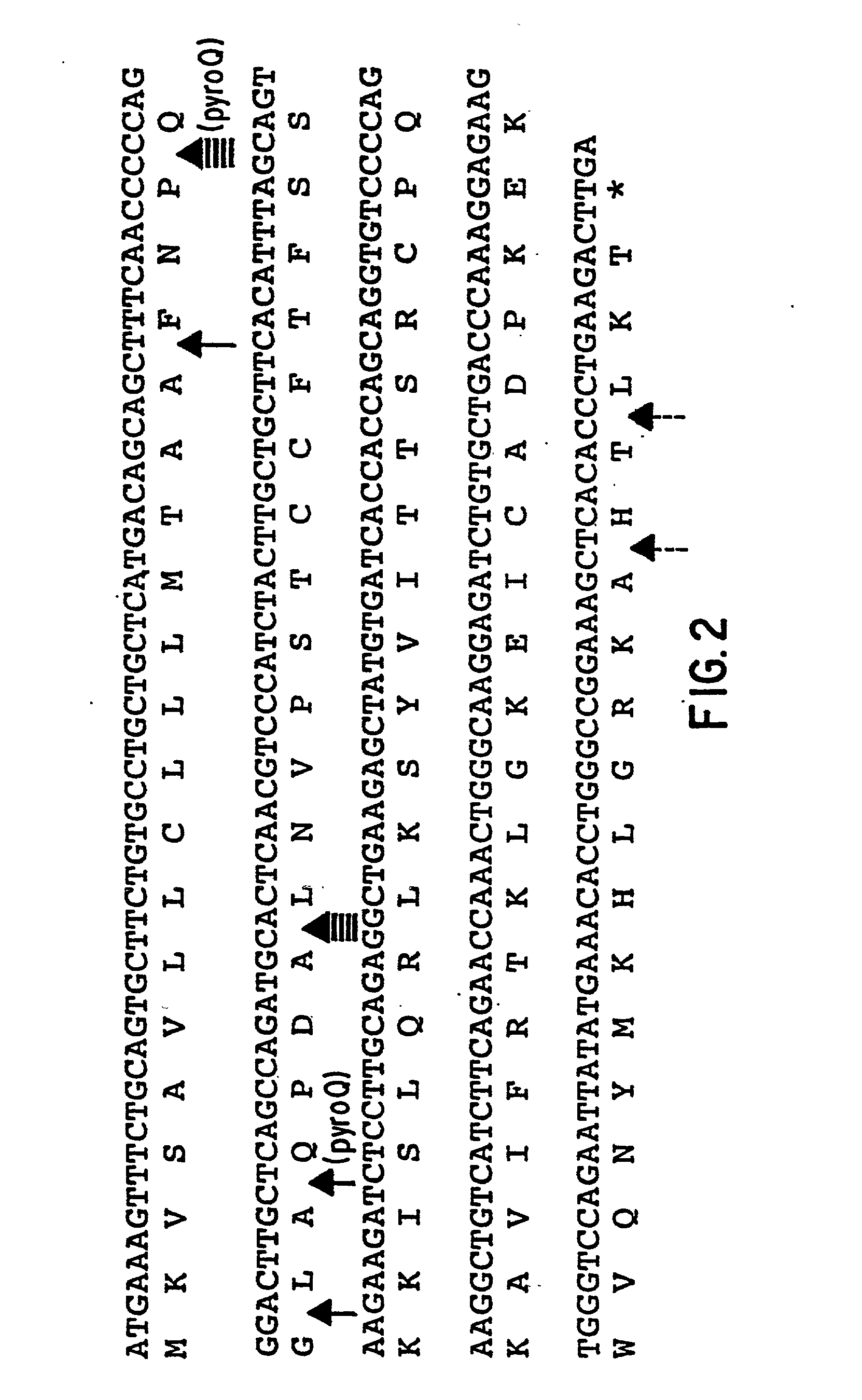Human chemokine beta-10 mutant polypeptides
a technology of chemokine beta10 and polypeptides, which is applied in the field of human chemokine beta10 mutant polypeptides, can solve the problems of inability to predict the exact cleavage point(s) of a given protein, the method does not always produce the same predicted cleavage point(s) for a given protein, and the cleavage site sometimes differs
- Summary
- Abstract
- Description
- Claims
- Application Information
AI Technical Summary
Problems solved by technology
Method used
Image
Examples
example 2
Bacterial Expression and Purification of MCP-4
[0657] The cDNA sequence coding for MCP-4 (also referred to as Ck.beta.-10), which is present in the human cDNA in the deposit in ATCC No. 75849, is initially amplified using PCR oligonucleotide primers corresponding to the 5' and 3' sequences of the processed MCP-4 protein (minus the signal peptide sequence) and the vector sequences 3' to the MCP-4 gene. Additional nucleotides corresponding to MCP-4 were added to the 5' and 3' sequences respectively. The 5' oligonucleotide primer has the sequence (SEQ ID NO:7) 5'CCCGCATGCAGCCAGATGCACTCAACG 3' contains a SphI restriction enzyme site followed by 19 nucleotides of MCP-4 coding sequence (underlined) starting from the sequences coding for the mature protein. The ATG codon is included in the SphI site. The 3' sequence, (SEQ ID NO:8) 5'AAAGGATCCAGTCTTCAGGGTGTGAGCT 3' contains complementary sequences to a BamH1 site and is followed by 19 nucleotides of gene specific sequences preceding the term...
example 3
Expression of Recombinant Ck.beta.-4 in COS Cells
[0658] The expression of plasmid, Ck.beta.-4 HA is derived from a vector pcDNAI / Amp (Invitrogen) containing: 1) SV40 origin of replication, 2) ampicillin resistance gene, 3) E. coli replication origin, 4) CMV promoter followed by a polylinker region, a SV40 intron and polyadenylation site. A DNA fragment encoding the entire Ck.beta.-4 precursor and a HA tag fused in frame to its 3' end was cloned into the polylinker region of the vector, therefore, the recombinant protein expression is directed under the CMV promoter. The HA tag correspond to an epitope derived from the influenza hemagglutinin protein as previously described (I. Wilson, H. Niman, R. Heighten, A Cherenson, M. Connolly, and R. Lerner, 1984, Cell 37, 767). The infusion of HA tag to the target protein allows easy detection of the recombinant protein with an antibody that recognizes the HA epitope.
[0659] The plasmid construction strategy is described as follows:
[0660] The ...
example 4
Expression of Recombinant MCP-4 in COS Cells
[0661] The expression of plasmid, MCP-4-HA (also referred to as Ck.beta.-10 HA) is derived from a vector pcDNAI / Amp (Invitrogen) containing: 1) SV40 origin of replication, 2) ampicillin resistance gene, 3) E. coli replication origin, 4) CMV promoter followed by a polylinker region, a SV40 intron and polyadenylation site. A DNA fragment encoding the entire MCP-4 precursor and a HA tag fused in frame to its 3' end was cloned into the polylinker region of the vector, therefore, the recombinant protein expression is directed under the CMV promoter. The HA tag correspond to an epitope derived from the influenza hemagglutinin protein as previously described (I. Wilson, H. Niman, R. Heighten, A Cherenson, M. Connolly, and R. Lemer, 1984, Cell 37, 767). The infusion of HA tag to the target protein allows easy detection of the recombinant protein with an antibody that recognizes the HA epitope.
[0662] The plasmid construction strategy is described a...
PUM
| Property | Measurement | Unit |
|---|---|---|
| pharmaceutical composition | aaaaa | aaaaa |
Abstract
Description
Claims
Application Information
 Login to View More
Login to View More - R&D
- Intellectual Property
- Life Sciences
- Materials
- Tech Scout
- Unparalleled Data Quality
- Higher Quality Content
- 60% Fewer Hallucinations
Browse by: Latest US Patents, China's latest patents, Technical Efficacy Thesaurus, Application Domain, Technology Topic, Popular Technical Reports.
© 2025 PatSnap. All rights reserved.Legal|Privacy policy|Modern Slavery Act Transparency Statement|Sitemap|About US| Contact US: help@patsnap.com



